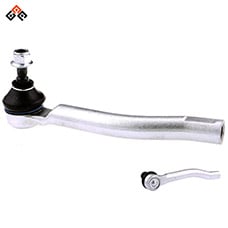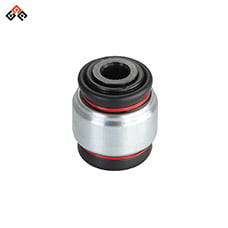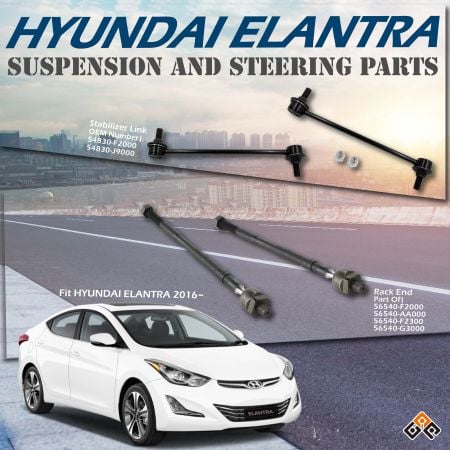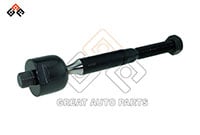Ball Joints
High-Strength Ball Joint Tested: Longevity Guaranteed
Understanding Ball Joints: What They Are and How They Work
Ball joints are fundamental components in a vehicle's suspension system, providing pivotal connections between the suspension and wheels. Essential for accurate steering and a smooth ride, these spherical bearings resemble the human hip joint, offering a wide range of motion. They typically include a bearing stud and socket enclosed in a casing, allowing for efficient control transfer from the suspension to the steering knuckles, which steers the wheels.
Ball joints consist of a hardened steel ball or stud within a steel or plastic bearing cup, encased in a durable housing pressed or threaded into the control arm. Sealed lubricants ensure smooth articulation and reduce wear.
Functioning on the principle of rotational movement, ball joints serve as flexible pivot points linking the control arms to the steering knuckles. This connection maintains wheel contact with the road, providing maneuverability through turns and over uneven surfaces. Built to endure substantial force, ball joints facilitate efficient rotational and angular movement, minimizing wear and stress while maximizing flexibility and responsiveness. Their robust construction and multifunctional operation are crucial for ride comfort, handling, and safety, underscoring their indispensable role in automotive mechanics.
Relationship Between Ball Joints and Other Suspension Components
The relationship between ball joints and other suspension components is intricate and interdependent.
| Component | Relationship to Ball Joints |
| Control Arms | Ball joints act as a bridge between the suspension system's control arms and steering knuckles. They facilitate precise control over the motion of the wheels, ensuring that your vehicle responds accurately to steering commands. |
| Steering Knuckles | They facilitate precise control over the motion of the wheels, ensuring that your vehicle responds accurately to steering commands. |
| Steering Rack and Arms | When you turn your steering wheel, this action is transferred through the steering rack and steering arms, ultimately arriving at the ball joints that pivot and allow wheel movement. |
| Suspension System | The smoothness of a ride substantially relies on these joints, as they cushion and absorb the road irregularities, thus transferring less vibration and shock to the cabin. |
| Wheel Hub | Ball joints act as a bridge between the suspension system's control arms and steering knuckles. They facilitate precise control over the motion of the wheels, ensuring that your vehicle responds accurately to steering commands. |
| Chassis | Ball joints act as a bridge between the suspension system's control arms and steering knuckles. They facilitate precise control over the motion of the wheels, ensuring that your vehicle responds accurately to steering commands. |
| Shock Absorbers | The smoothness of a ride substantially relies on these joints, as they cushion and absorb the road irregularities, thus transferring less vibration and shock to the cabin. |
| Springs | They cushion and absorb the road irregularities, thus transferring less vibration and shock to the cabin. |
| Vehicle Weight | Ball joints are the unsung heroes that bear the weight of your vehicle while allowing the suspension to articulate, which means your ride's comfort, handling, and alignment are significantly influenced by their condition. |
| Tires | As they wear over time, you might notice vague steering and uneven tire wear, signaling the need for inspection or replacement. |
Types of Ball Joints: Upper vs. Lower and Their Functions
Upper and lower ball joints have distinct roles that contribute to the overall stability and articulation of the vehicle. Upper ball joints are typically found in vehicles with a control arm suspension setup. They are positioned at the top of the wheel hub, connecting to the upper control arm, allowing the suspension to move up and down while maintaining accurate wheel alignment.
The primary function of upper ball records is to bear the vehicle's vertical load and facilitate precise steering. They typically experience less wear and tear compared to lower ball joints due to the distribution of the vehicle's weight.
Lower ball joints, on the other hand, are situated at the bottom of the suspension system and are often subject to greater operational stress. They connect the lower control arm to the wheel hub, providing the pivot point for the wheel to move up and down and side to side. Due to their position, lower ball joints support a significant portion of the vehicle's weight and absorb much of the impact from the road. This means they often have a more robust design with increased durability to withstand the forces encountered during driving.
Upper and Lower Ball Joints Design
The design differences between upper and lower ball joints reflect the varying levels of stress they encounter. Upper ball joints may have a lighter design with less emphasis on sheer strength, while lower ball joints are typically sturdier to handle compressive loads. Operational stress also dictates the materials used and the protective measures like boot seals for preventing debris intrusion. It is crucial for vehicle owners to understand these differences, as they have implications for maintenance and replacement. Regular inspections are necessary to ensure the integrity of both upper and lower ball joints, as their wear can significantly affect vehicle safety and performance.
Top Signs Your Ball Joint Needs Immediate Replacement
These spherical bearings connect the control arms to the steering knuckles and allow for proper wheel alignment. Over time, ball joints can wear out and require replacement.
- Uneven Tire Wear: Check for uneven tire wear. If the tread wears more on one side, the ball joint may be worn and unable to maintain proper wheel position.
- Clunking Noises: Listen for clunking or knocking sounds from the front suspension when driving over bumps or making sharp turns. This noise suggests loose ball joints knocking against their housings.
- Excessive Vibration: Feel for excessive steering wheel vibration, especially at higher speeds or when accelerating. This indicates a deteriorating ball joint causing instability in wheel movement.
How to Test and Inspect Ball Joints for Wear
Step 1: Prepare Your Workspace
- Ensure the workspace is safe.
- Securely lift the vehicle using jacks or a lift.
- Place wheel chocks to prevent movement.
- Gather necessary tools: floor jack, jack stands, pry bar, and flashlight.
Step 2: Raise and Support the Vehicle
- Raise the vehicle and support it properly with jack stands.
- Remove the wheel nearest to the ball joint you're inspecting.
Step 3: Check for Excessive Movement
- Place a pry bar beneath the tire and lever it upward.
- Observe for excessive movement, which may indicate a worn ball joint.
- Inspect the rubber boots for tears or leaks.
Step 4: Test the Steering Knuckle
- Grasp the steering knuckle and attempt to move it up and down or side to side.
- Check for minimal play; significant play or unusual sounds indicate wear.
Step 5: Inspect for Uneven Tire Wear
- For rigid or non-serviceable ball joints, lack of movement could still indicate issues.
- Check for uneven tire wear, symptomatic of worn ball joints.
Step 6: Use a Dial Indicator
- For confirmation, use a dial indicator to measure the actual play in the ball joint.
- Position the dial indicator against the bottom of the ball joint and measure any movement.
Preventive Maintenance Tips for Ball Joints
Regular ball joint maintenance is crucial to make sure your vehicle's suspension system remains reliable. Neglecting this can lead to steering problems, uneven tire wear, safety hazards, and costly repairs.
- Conduct regular inspections: Ideally during every oil change or at least twice a year. Look for signs of wear such as wheel looseness or uneven tire wear. Consult your vehicle's manual for specific intervals, and seek a professional mechanic's assessment if unsure.
- Lubrication is also key: Many modern vehicles have sealed ball joints, but if yours are serviceable, apply grease as directed by your vehicle’s manual. It's best to lubricate ball joints every oil change or according to your vehicle's service guide.
- Regular alignment checks: Ensure your vehicle's wheels and axles are aligned reduces stress on the ball joints, significantly prolonging their lifespan.
What Causes Ball Joints to Wear Out?
Ball joints are critical components in the suspension systems of vehicles, acting as pivot points between the wheels and the suspension. Over time, these joints can experience wear and tear due to various reasons.
- Driving Conditions: Frequent driving on rough, uneven roads or over potholes accelerates ball joint degradation. These harsh conditions put additional stress on the ball joints, leading to faster wear.
- Weight and Load: Heavier loads can cause excessive stress and strain, wearing down the ball joints more quickly. This is especially true for vehicles that regularly carry heavy cargo or tow trailers, where the increased weight compounds the wear.
- Mechanical Wear Over Time: Constant friction during articulation leads to material loss and clearance issues. Adequate lubrication reduces friction and wear, while a lack of it can cause metal-on-metal contact, leading to rapid degradation. Sealed ball joints keep the lubricant inside and contaminants out, prolonging their lifespan.
- Regular Maintenance: Regular maintenance checks are crucial to ensure adequate lubrication and to replace ball joints before severe wear compromises vehicle safety and handling.
Choosing Great Auto Parts Ball Joint: The Right Ball Joint for Your Car
When it comes to enhancing your vehicle’s performance and handling, don't overlook the critical suspension system. Great Auto Parts offers top-quality suspension solutions designed to ensure longevity and reliability.
OE-Based Suspension Solutions for Enhanced Installation Convenience
At Great Auto Parts, we prioritize customer needs by developing suspension solutions based on OE product dimensions. This ensures our products deliver exceptional performance and easy installation, aligning perfectly with your vehicle's specifications. Our expert team provides guidance to seamlessly integrate our suspension systems with your vehicle, elevating your driving experience.
Strength and Durability Assured
Our ball joints feature heat-treated bolts, offering both exceptional strength and outstanding durability. In the event of a collision, our ball joint bolts may bend but won't break, avoiding catastrophic consequences and ensuring your safety.
Superior Performance and Longevity
Great Auto Parts' ball joints undergo rigorous high-strength pull-off testing and feature low axial clearance values. This means they deliver superior performance and longevity, whether you're an enthusiast, a racing team, or a vehicle customization shop. Our suspension products meet your needs and significantly enhance your vehicle's performance.
Choose Great Auto Parts for reliable, high-quality ball joints that keep your vehicle running smoothly and safely.






